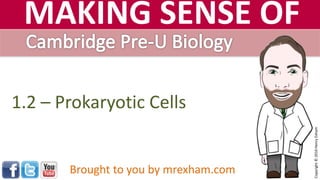
Cambridge Pre-U Biology - 1.2 Prokaryotic Cells
- 1. MAKING SENSE OF Icons CC – The Pink Group Copyright©2017HenryExham
- 2. Copyright © 2016 Henry Exham • All cells can be split into two categories. 2 Prokaryotic Cells Eukaryotic Cells • The major difference is that prokaryotes don’t have a nucleus whereas eukaryotes do.
- 3. Copyright © 2016 Henry Exham • Animals, plants, fungi and protoctists are all made of eukaryotic cells, but we believe they all evolved from simpler cells that lack a nucleus called prokaryotic cells. • Prokaryotic cells have some features in common with eukaryotic cells but also many differences. • All bacteria are examples of prokaryotic cells. 3
- 4. Copyright © 2016 Henry Exham • Although they are basic organisms they are very important in biology. – They can be found in a huge range of environments. – They are responsible for the decay of organic material. – They are pathogens of many organisms. – We can exploit them and use them for processes in biotechnology. – They contribute significantly to your health. 4
- 5. MAKING SENSE OFMAKING SENSE OF Structure of prokaryotic cells Antibiotics Reproduction Pathogenic bacteria 5
- 6. Copyright © 2016 Henry Exham a) Outline key structural features of prokaryotic cells including: unicellular, 1-5 m diameter, peptidoglycan cell walls, lack of membrane-bound organelles, naked circular DNA, 70S ribosomes. b) Outline the structure of the cell walls of Gram-positive and Gram- negative bacteria and the significance of the structure for the use of antibiotics. c) Explain the mode of transmission and infection of Agrobacterium tumefaciens as an example of a bacterial pathogen. d) Explain the mode of action of penicillin on bacteria (as an example of an antibiotic) and explain why penicillin does not affect viruses. e) Outline the mechanism of asexual reproduction by binary fission in a typical prokaryote.
- 7. Copyright © 2016 Henry Exham 7 • Prokaryotes come in many shapes and sizes but the two main groups are the cocci (round) and bacilli (rod shaped). • This often forms part of their binomial name e.g. Lactobacillus used to make yogurt.
- 8. Copyright © 2016 Henry Exham 8 Here is a scanning electron micrograph of Escherichia coli bacteria Prokaryotes are very small (1 – 5mm diameter) compared to a typical eukaryotic cell (can be up to 40mm in diameter).
- 9. Copyright © 2016 Henry Exham 9 You can see the size difference nicely on this image of a squamous epithelial cell from a human which is covered with many Lactobacillus bacteria.
- 10. Copyright © 2016 Henry Exham 10 These bacteria are called Staphylococcus aureus and will be discussed later in the course.
- 11. Copyright © 2016 Henry Exham • All prokaryotes possess the following structures: • These additional structures are sometimes present: 1. Cell wall 2. Cell membrane 3. Cytoplasm 4. DNA 5. Ribosomes 11 1. Capsule 2. Infolding of membrane 3. Plasmids 4. Flagella 5. Pili
- 12. Copyright © 2016 Henry Exham • Prevents the cell bursting and gives bacteria it’s shape. • Made of murein which is peptidoglycan (a combination of polysaccharide and protein.) • There are two types of cell wall which are discussed further in this section. Cell wall 12
- 13. Copyright © 2016 Henry Exham • The cell membrane is broadly the same as the cell membrane in eukaryotes. • The detailed structure of membranes is discussed in section 1.2. • The cytoplasm is also similar but does not contain a cytoskeleton. Cell membrane 13 Cytoplasm
- 14. Copyright © 2016 Henry Exham To download the whole presentation visit www.MrExham.com
- 15. This PowerPoint is protected under copyright. It is designed for educational use. Either personal study or to be presented to a class. It may be edited or duplicated for these purposes only. It must not be shared or distributed online in any format. Some images used are under a separate creative commons license, these are clearly marked. Copyright © 2016 Henry Exham Brought to you by MrExham.com
Editor's Notes
- Bacteria facts: 1kg of your body weight are bacteria. In one kiss you can exchange up to 1 billion bacteria.
